
Effective price execution is typically a core competency in any industry and particularly so for CPG organizations. Structural aspects of the CPG industry – i.e. inexpensive and frequent transactions – enable CPG manufacturers to capture a wealth of data making them ideal candidates to take the lead on deploying sophisticated analytical techniques for better revenue management.
CPG companies have a tremendous opportunity to use data as a source of competitive advantage and it’s not uncommon for such companies to see 200-500 basis points of earnings growth through a more analytically rigorous price setting and promotions management process.
Most CPG companies have historically set prices using a cost plus approach to meet corporate Gross Margin thresholds and then relied heavily on high-low promotional discounting to meet revenue targets. This approach almost certainly leaves margin on the table because customers don’t purchase based on the price they pay but on the value they get in exchange for a price. Cost plus doesn’t permit adjusting price in response to changing demand conditions. This article describes a comprehensive value based price setting and promotional execution framework that FMCG manufactures can adopt to maximize contribution profits using a shelf-back pricing approach. Thee key principles outlined here can be applied to any upstream organization that needs to reach the end consumer through a channel intermediary.
What is shelf-back pricing?
Shelf back pricing entails estimating what the optimal consumer shelf price for a product is, and then working back to what the CPG manufacturer’s sell-in price should be to a retailer. Finally, it entails determining in what form, value chain margin should be shared with the retailer on an ongoing basis.
The figure below visually illustrates the various steps that a shelf back price setting approach entails.
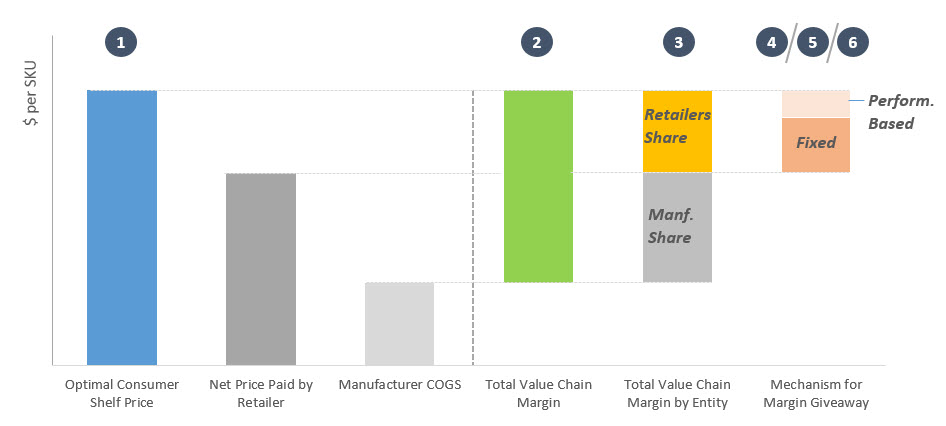
- Using price elasticities to estimate the optimal consumer price architecture for a SKU and its product family
- Using the optimal shelf price and manufacturer COGS to estimate total potential value chain margin
- Estimating what the value chain margin split should be between the CPG manufacturer and channel partner by understanding each entity’s structural leverage
- Aligning on a pricing and promotional strategy to determine what proportion of the margin to share with a retailer via permanent (i.e. list prices) and promotional (i.e. gross-to-net) discounts
- Developing a trade architecture for the account level deployment of trade promotion dollars
- Allocating dollars to different promotional tactics and measuring results
1. Calculating optimal shelf prices
The first step consists of determining the value that end consumers assign to a product by channel and the subsequent price point that mathematically optimizes the total value chain contribution margin of the product. Because most CPG manufacturers have access to large amounts of point-of-sale data which includes volumes transacted at varying price points across periods, they can use that to compute the price elasticities of any given SKU which can inform the pricing decision.
The calculation of elasticities can involve a lot of nuances, however broadly speaking, best in class methods involve compiling a transactional dataset of SKU level prices by channel aggregated at the daily or weekly level and their associated sell-out volumes, along with competitive product price points and categorical flags for whether the product was featured at the time of sale or not. The coefficient of the linear regression model between the natural log of volume and natural log of price is the own-price elasticity of the SKU and is typically a number between -1 and -4. The way to interpret the elasticity of a log-log model is the percent change in the product’s volume brought about by a 1% change in price, so if elasticity was -3.1, it suggests that a 1% price cut would result in a 3.1% increase in volume or vice versa. A number closer to zero is more favorable for the CPG company. For low margin products that are highly elastic, a price cut might stimulate sales, but it is unlikely to stimulate total profits and elasticities allow manufacturers to quantify that tradeoff and calculate the breakeven point.
What follows is the inverse elasticity rule or Lerner index which gives us a theoretically optimal consumer price. It can be calculated as follows:
Optimal unit price for a SKU = ( Elasticity / (1+ Elasticity) ) * unit cost
The inverse elasticity rule provides a good starting point to determine what price to charge on the shelf to a consumer to maximize combined value chain margin. It does however need to be evaluated and adjusted based on recent developments in the competitive landscape, the broader product portfolio and it must be within historically acceptable price bands. In particular, CPG manufactures must ensure that consumer pricing of the various pack sizes in a product line makes sense. While the math for this step can be fairly involved, broadly speaking, the list price architecture for a SKU must resemble the curve below where the price per unit in a case decreases for SKUs that are sold in larger pack sizes.

2. Calculating total value chain margin
The difference between the optimal shelf price calculated in the previous step and the manufacturer’s Cost of Goods Sold is the total value chain margin for a SKU. It represents the upper bound of profit that can be generated and shared between manufacturer and channel partner. The key issue of course is determining how this margin should be split between the two stakeholder groups.
3. Estimating what the value chain margin split should be between manufacturer and retailer
The CPG company owns and makes the actual brands but the channel partner owns the critical distribution infrastructure to the end consumer without which no transactions would occur. So whose value proposition is greater and more deserving of a greater share of total margin? The factors that tend to determine this split include regulatory constraints, channel concentration, product category market share, availability of substitutes and local cultural practices. In other words, the classic economic principles of scarcity can be applied to answer this question.
The figure below can help to predict the value chain margin split given the primary drivers of structural leverage in a largely free and unregulated market.
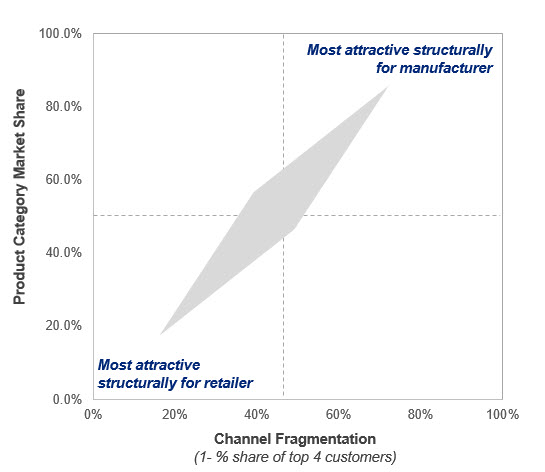
On the horizontal axis is channel fragmentation which is defined as 1 minus the share of total sales associated with the top 4 channel partners in a market for a given SKU. This metric measures the structural leverage of retailers and distributors. The vertical axis illustrates the market share of the product category that the SKU belongs to. It’s a proxy for product attractiveness and the structural leverage of a manufacturer. If a SKU is positioned in the bottom left hand of this figure (poor share in a highly concentrated retail/distributor landscape), expect the channel partners to capture the lion share of the total value chain margin. Conversely, if a product is positioned on the top right hand side of this figure (a highly in demand product in a fragmented retail market), expect the CPG manufacturer to capture a greater share of the value chain margin.
While benchmarks exist that enable the plotting of a curve which can predict the splits likely to occur by category in any scenario for a local market, the following is a good rule of thumb. In moderately concentrated modern trade markets where the top 4 retailers control less than half of a product’s sales and where the SKU belongs to the leading or number two product line in a category, the manufacturer can expect to capture ~65% of the total value chain margin for most common product categories.
Next, the CPG manufacturer must determine how to achieve this net price target via a combination of list prices and promotional discounts.
4. Structuring the margin giveaway via list prices and promotional discounts
Let’s assume that steps one to three above result in an optimal consumer shelf price estimate of $4 for a SKU that has a manufacturing COGS of $1. Furthermore, let’s assume that market dynamics suggest that 60% of the combined value chain margin should accrue to the manufacturer which is the goal that the manufacturer sets for themselves. This would suggest that the net price paid by the retailer for the SKU should be $2.8 (i.e. 0.6*(4-1) + 1) on average.
The critical decision to be made at this point is to how to structure the list price and discount waterfall for the SKU. Broadly speaking, on one extreme, the manufacturer could decide to set a list price of $2.8, and not ever provide any discounts on the product. Alternatively, they could choose to set a really high list price that’s even higher than the shelf price, e.g. $6, and give each customer deep discounts of over 50% to get to the same target average net price of $2.8. The right approach, as is often the case, lies in the middle. List or gross price should always be greater than a target net price in the b2b space to allow for account specific price discounting which wouldn’t be possible in the former scenario. It also helps to give the retailer the psychological fulfillment of receiving some discounts during negotiations. Conversely, if list prices are set too high, they become a meaningless number that serve no real purpose. Think of the list prices posted on the back of the door of hotel guest rooms which are often 3-5x average net price per night. They effectively end up serving little purpose.
The truth is that there is some art to the list price setting process. The right approach tends to depend upon the diversity of the channel landscape but a good rule of thumb is that CPG manufactures should set list price levels between the optimal shelf price and the target channel net price such that they reflect a price level that a low leverage mom and pop retailer account would be willing to pay. Furthermore, this approach allows CPG companies to anchor to this price during retailer negotiations which wouldn’t be possible if the price level was set to be unreasonably high. This would then also allow the CPG company some room to give mega accounts deeper discounts.
The figure below visually illustrates the sharing of value chain margin with the channel partner as a function of list prices versus trade discounts
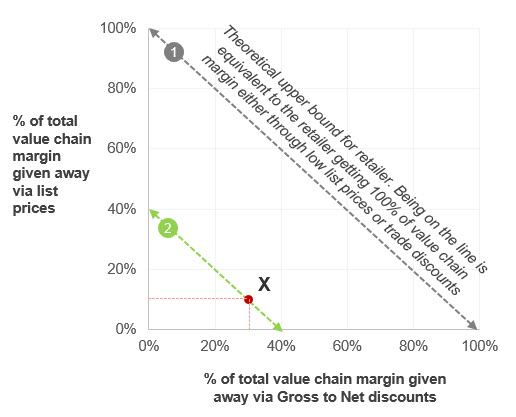
The grey horizontal line (line 1) shows the theoretical extreme scenario where a manufacturer concedes the entire value chain margin to the retailer either through low list prices or trade promotion (gross-to-net) discounts. Continuing with the example above, if our manufacturer decides that they should target capturing 60% of the value chain margin on a given SKU, then at the aggregate level, they have 40% to concede to their channel partners. They can do so by positioning themselves anywhere on the green line (labeled 2) above. If the manufacturer faces a diverse retailer landscape, they might choose a price structure indicated by point X where 10% of combined margin is shared via list prices and 30% via promotional discounts. Continuing with the assumptions in the example above, the resulting price architecture for the SKU entails a customer shelf price of $4, a manufacturer list price of $3.7 per SKU ($4-(3*0.1)) and average trade promotion discounts across all customers of $0.9 per SKU (0.3*$3) to end up with a net manufacturer average sell-in price of $2.8 per SKU and a COGS of $1. This price architecture is depicted visually below.
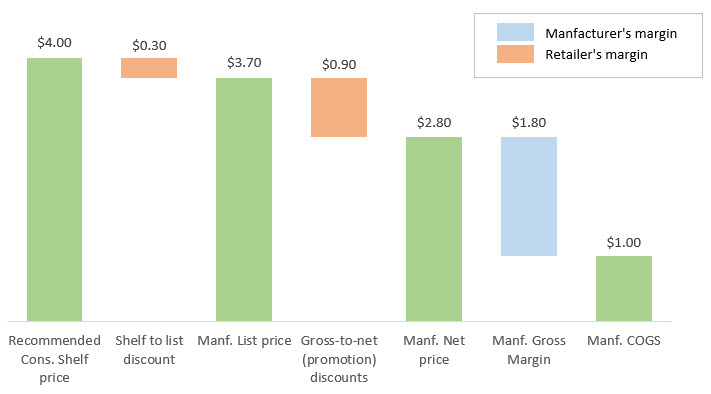
5. Setting account level net prices – i.e. Designing a trade architecture
While a manufacturer can target a value chain margin share capture using the methodology described in step 3, the reality is that it will be a channel average with variation at the account level. This should make sense intuitively as Walmart cannot be expected to pay the same net price for a carton of milk or a bottle of cough syrup as a mom and pop retailer. Because the list prices are fixed by definition, the variation needs to occur in the gross-to-net trade discounts across accounts. What differentiates best-in-class CPG players from average ones is the structure underpinning this variation. In other words, their trade promotions architecture.
The importance of having a well thought out trade promotion architecture cannot be overstated. Trade promotion spending is typically the second largest cost line item after COGS for a FMCG company and according to a recent BCG study, trade promotion spending has outpaced revenue growth over the past decade. A key reason it doesn’t get much attention by Wall Street or corporate executives is that GAAP and IFRS don’t require reporting it as it’s ‘above the line’ and often not thought of as ‘real money’. This however could not be farther from the truth. Any improvements in trade spending directly translate into margin for a CPG manufacturer.
Designing a trade architecture can be a tricky and involved exercise however it boils down to a few fundamental principles:
- Account level promotional investment (i.e. funding) should be aligned with account value and be tied to account performance
- The incentives given to the channel partners should be aligned with key brand priorities
Let’s explore these principles in a little more detail.
The logic underlying the first principle should be intuitive. The more valuable an account is for a CPG manufacturer, the greater trade funding it should receive. In other words, trade investments should be deployed to the highest ROI opportunities. Value here can be a combination of factors but is typically measured through a combination of metrics such as total sales volume and sales growth. The channel partners who are willing to purchase the greatest amounts or have the potential to grow the fastest should be the ones receiving the most trade investments so that the CPG manufactures can win with the winners.
The figure below shows two scenarios of account level trade funding rates compared to account value. Each dot represents a channel partner.

The horizontal axis on both charts represents total customer account level sales or growth rate, and vertical axis represents the trade promo rate (i.e. trade funding / gross sales). The scenario on the left is suboptimal because there is no logical correlation between account value and funding rate. Multiple low value accounts are receiving trade investments on par with the most valuable accounts. This represents a poor deployment of funds. Alternatively, the scenario on the right indicates that accounts have been segmented into three categories with each segment receiving a trade funding rate that is proportional to its value. The criteria used to segment accounts can vary but at minimum should include sales volume and growth. For a comprehensive approach to action segmentation, refer to this guide published by Monitor Deloitte.
In my experience working with several large CPG clients – several of whom claim to have a pay-for-performance trade structure on paper – most have an account portfolio that resembles the figure on the left more so than the one on the right. In fact, this simple framework can enable a CPG manufacturer to quantify the size of their trade promotion spend optimization opportunity with a high degree of confidence.
The second major guiding principle for designing a trade architecture is ensuring that the funding model includes incentives for behavior that align with the brand’s strategic priorities. Often these priorities tend to include:
- Assortment (i.e. carrying the full portfolio of SKUs)
- Shelving (i.e. placing the product in a premium location such as on eye level shelves or at the check-out counter)
- Promotional commitments (i.e. commitments to promote the product in certain high demand periods such as back to school season)
CPG manufacturers need to ensure that once they’ve determined the hierarchy of their brand’s priorities, they align trade funding levels with those priorities and communicate them to retailers to ensure there is explicit alignment of desired behavior between channel partners.
Funding models – How much to fund a specific account?
While the desired outcome is always the same (an alignment of funding to performance), the models available to fund accounts can vary. There has been a proliferation of models over the years, but we can broadly classify funding models by the two edge cases:
A. Completely ad-hoc
B. Completely structured (live rate accruals)
In the first case, allocation of trade funding to accounts is a bottom up exercise that is done retailer-by-retailer on an annual or quarterly basis via consensus meetings with input from the Sales, Finance, Brand and Marketing teams. Its purpose is to place strategic bets with a handful of key accounts whom the CPG manufacturer would like to “win with”.
In the second case, funding is completely structured as a function of performance. In other words, every retailer is segmented into a group and given a base funding rate (a certain percent of gross sales) along with an opportunity to earn some “kickers” for adhering to the strategic brand priorities discussed above. That way, as the retailer does business with the CPG manufacturer, they accrue promotional funds based on their pre-established rate. Those funds can then be put to use towards a variety of tactics. There are three high level sub-variations of this model that are common in the industry:
- The first is a simple live rate accrual that is a function of a segment specific funding rate. Under this model, the channel partner is assigned a funding rate but in principal does not have a say in the rate
- The second is a menu based option where the CPG manufacturer presents the retailer a menu of strategic provisions (e.g. assortment and visibility related) and lets the channel partner design their own live rate by opting in and out of certain provisions
- The third is a hybrid model where each retailer gets a base rate determined by their segment and gets to build on it via ‘kickers’ by opting into additional optional provisions
As stated earlier, both the ad-hoc and structured methods are intended, in principal, to achieve the same goal which is to align account level trade funding with value. In practice however, it is much more challenging to achieve this goal with an ad-hoc model and the likelihood of ending up with an account portfolio where value is misaligned with funding is much greater under such a funding model. Live rate models also make it easier to structure trade investments as retroactive and performance based as by definition, they are accruals. Ad hoc models conversely give channel partners more leverage to negotiate for on-invoice discounts that aren’t tied to performance.
Also, recall that a desired outcome of step 4 was determining a target channel level average value chain margin split as a function of structural dynamics between CPG manufacturers and retailers. Ensuring that the weighted average performance across all accounts adheres to this overall target is much simpler under the structured live rate model versus the ad-hoc account funding model.
It is no surprise then that best-in-class FMCG companies gravitate towards structured live rate models for their trade promotions management.
A word of caution here. Any proposed trade architecture needs to be assessed for its legality and compliance with the Robinson-Packman act which is designed to prevent blatant price discrimination by manufacturers. Details for it can be found here.
6. Determining what promotional tactics to run and how to compensate the channel partner for them?
Once a decision is made on how to fund an account, the next decision is what tactics to deploy those funds against. Should a CPG manufacturer push for rebates? hi-low pricing? coupons? feature ads? Furthermore, how should they structure the compensation associated with these tactics?
This depends on a few key issues, namely:
- ROI of the alternatives
- Leverage and bargaining power of retailer vs. the CPG manufacturer
- Presence of a JBP program between the two parties
- Strategic importance of the channel partner account
- Retail strategy of the channel partner
- Culture of the local market
The figure below illustrates typical tactics and compensation mechanisms:
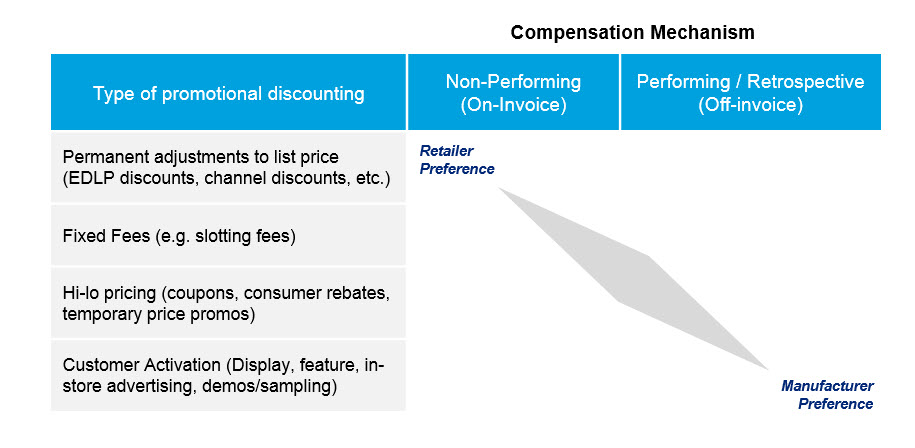
Large retailers are likely to push for on-invoice permanent adjustments to list price that are structured to be paid on a non-performing basis. In other words, they want a guarantee that they will be able to buy a widget at the lowest possible unit price without committing to any minimum volumes. CPG manufactures on the other hand, are more likely to push for temporary price reductions and brand building / customer activation tactics such as in-store displays and would want to structure payments associated with outcomes such as volume or lift.
The same framework discussed in step 3 (in the context of total value chain margin sharing) can be applied here to determine the structural leverage of each entity and the tactics that are more likely to prevail.
Large markets where bargaining power between both parties is roughly even, have in recent times seen the widespread adoption of Joint Business Planning Programs where commercial teams from both sides get together and share data, forecasts and plans to design win-win ROI outcomes. JBP programs between retailers and FMCG manufacturers are fast becoming the industry standard in modern trade markets.
Other factors that are likely to have a major influence on the tactics deployed include the strategy of the retailer and cultural norms. For example, given Walmart’s EDLP strategy, they are certain to demand permanent price adjustments whereas Target and CVS in the U.S. might be more interested in deeper temporary discounts to feed their hi-low strategy. Cultural norms of the local markets play an important role as well, for example, in some South East Asian markets, coupons are not as common as they are in Western European and North American markets and therefore less likely to be impactful. Similarly, in the Philippines for example, OTC drugs in drugstores are kept behind a physical counter therefore temporary price reductions combined with displays aren’t a very effective promotion tactic.
There are lots of subtleties associated with the deployment of promo funds to tactics however it ultimately all boils down to ROI and CLV.
Promotional spending is by definition an investment to accelerate sales either by inducing existing customers to buy more or by acquiring new customers that would otherwise not have purchased the product. Both of these phenomena need to be quantified to ensure effective deployment of funds.
Return on investment or ROI is simply the incremental benefits divided by the total investment required. More formally, it can be calculated as:
((Incremental revenue attributable to promotion x contribution margin %) – total promotion spend) / total promotion spend
The critical and often controversial metric here is incremental revenue or ‘lift’ which tends to spur contentious debates amongst sales reps and managers. It is critical because a reliable assessment of lift is key to accurately assessing the effectiveness of a promotion. Here are some guiding principles on estimating lift:
- It is best measured via sell-out volume. Third party and syndicated data sources such as AC Nielsen and IRI provide a breakdown of base and lift retail sales. These are objective, rooted in statistical rigor and should work for most companies. Many CPG companies also design their trade architecture to incent channel partners to share sell-out data when syndicated data isn’t available. For a comprehensive approach to building a sell-out measurement and forecasting system, read this post.
- If sell-out data isn’t available, sell-through is a good alternative if the channel involves a distributor or other intermediary.
- Absent any other source, sell-in can be used to measure lift, however there must be some diligence done to ensure that the retailer isn’t stockpiling inventory.
Best practice entails measuring ROI at the event level on a pre (forecast) and post event (actuals) basis. ROI forecasts should be based on historical evidence of lift and should always be validated after the fact.
Also, note that leading CPG companies consider account fund allocation and trade tactic allocation an iterative exercise. In other words, they optimize for tactics within an account and if the evidence for ROI isn’t there across the array of tactics, funding for the overall account is realigned accordingly and those funds are deployed elsewhere.
Conclusion
Effective price setting and trade promotion management is no doubt a complex and analytically involved endeavor. Transforming a cost plus price setting process and a fragmented trade architecture to be more performance based and aligned to account value across a diverse array of global markets is an extremely challenging undertaking and requires competency across the Sales, Marketing, Finance, Supply Chain and IT functions.
Yet, the results are unambiguous. FMCG companies that do this well can earn 200-500 basis points in earnings growth which makes the efforts more than worthwhile.
The comprehensive framework outlined in this article should hopefully help you start to think about the right questions to ask in order to assess the health of your commercial strategy and to quantify the opportunities for improvement.
